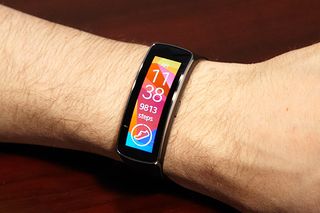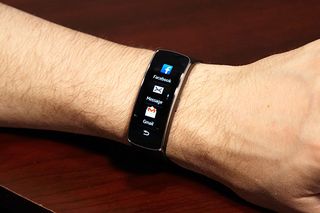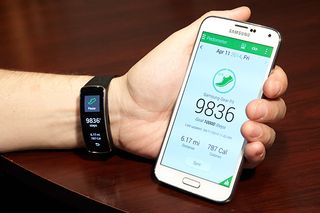Samsung Gear Fit: Smartwatch Review

The Samsung Gear Fit is not just a fitness tracker, or a smartwatch — it's both. The device, which costs about $200, combines smartwatch features, such as call and alarm notifications, with the functions of a more traditional fitness tracker, such as the ability to track daily steps and calories burned. It even includes a heart rate monitor that works when you're at rest or exercising. But is this hybrid better than a normal tracker? I tested the device to find out.
Overall Rating: 5.3/10
The pros of the Gear Fit include its sleek design and interactive display, the ability to receive notifications, and the inclusion of a "coach" in some versions of the tracker app that provides tips on how to live a healthy lifestyle.
The cons of the Gear Fit include the need for multiple apps to manage the device and view data, bugs in the app used on older versions of the Galaxy phone, and a lack of motivational messages.
Design/Comfort: 9/10
The Gear Fit stands out among smartwatches for its design. It has a sleek, slightly curved, rectangular screen that's big enough to read, without feeling bulky. An adjustable strap lets you fit the device snugly on your wrist. A single button will turn the display on and off, but the screen will also light up when you twist your wrist to look at the display, so you can see the screen even if your hands are full.
Since it is a smartwatch, wearing the device is like having a minicomputer or smartphone on your wrist. The display is colorful, and you can view different icons by swiping the screen. You can also pick from more than a dozen wallpapers to use as the screen background, so it's easy to color-coordinate the smartwatch with your outfit, if you're so inclined. (The wristband also comes in three colors: black, orange or grey.)

Features on the device include a timer, stopwatch and pedometer. It also provides a way to track your sleep and exercise (including walking, running, cycling or hiking), and check your heart rate. (The Gear Fit does not continuously track your heart rate, except during exercise sessions.) You can view most of your data on the Gear Fit itself. For example, selecting the pedometer icon shows you how many steps you walked; you can see a history of your daily steps over the last week, too.
Sign up for the Live Science daily newsletter now
Get the world’s most fascinating discoveries delivered straight to your inbox.
You can also set the device to receive notifications, including alerts of incoming calls, emails or alarms. The watch will sync wirelessly with your phone, though it only works with Samsung phones.
User-friendliness: 2/10
Using the smartwtach itself is fairly straightforward, but I encountered a number of frustrating moments while setting up the device and working with the accompanying apps.
First, if you use the smartwatch with a phone as old as or older than the Galaxy S4, you'll have to install not only an app to manage the device (the Gear Fit Manager), but also a separate app to view your data (the Fitness with Gear app). I didn't realize at first that I needed to take this extra step. If you have a Galaxy S5 phone, you can use the watch with the S Health app, which comes installed. Regardless of the version of your phone, you'll have to create a Samsung account. (Note: The Galaxy S4 does have an older version of the S Health app, but for some reason, you are not prompted to pair the Gear Fit with this app.)

The Fitness with Gear app had some bugs. At first, I could not see the details of my data because the app told me I needed to "sync with my Samsung account," even though I'd already done that. No further instructions were provided. Eventually, I was able to see these details, which included information like my total average steps and a monthly history of my activity. But the app would occasionally give me error messages, and I'd just have to try again later.
The S Health app is much nicer and does not have the same bugs. But it's still not particularly user-friendly. For one, it does not automatically sync with the pedometer on your Gear Fit. Instead, it uses the phone's built-in pedometer. To sync with your Gear Fit's pedometer, you have to select Pedometer in the S Health app, then the three-dots menu button, then select "Phone data to view" and then choose the Gear Fit device. This is not particularly intuitive.
The Galaxy S5 phone has a way to check your heart rate as well, and every time you open the Heart Rate section on the S Health app, it prompts you to place your finger on the phone's heart rate sensor. If you're interested in viewing the heart rate information you collect with the Gear Fit, you'll want to look at the heart rate Log section of the S Health app. Also, the Exercise section of the S Health app keeps a log of the calories you burn in a workout, and your average heart rate, but not your steps.
Although the older Fitness with Gear app has a section to view details about your sleep data, the newer S Health app does not. So if you track your sleep with your Gear Fit, you'll only be able to view the data on the Gear Fit device itself, unless you download a separate app called S Health Sleep. Three apps for one tracker (Gear Fit Manager, S Health and S Health Sleep) seems a bit much.
Finally, although the Gear Fit device has a pedometer, it does not start counting your steps until you hit the Start icon on the device. Once you do, it will always count your steps, unless you hit Pause on the pedometer.
Value of Information: 4/10
The Coach section of the S Health app on the Galaxy S5 provides some information to put the data you're tracking into context. In this area, you can perform an assessment of your exercise, food and sleep habits, as well as your stress level and weight. For example, if the assessment finds that you are not exercising very often, Coach will suggest that you increase the number of times you exercise a week, also offering specific "missions" that you can carry out to accomplish your goal, such as taking a speedy, 20-minute walk twice a week or upping your steps to 10,000 per day.
Information from the workouts you track with Gear Fit or the Galaxy S5 itself will automatically go toward completing these missions/exercise goals, or you can simply tell Coach that you completed a goal that day.
If you're interested in improving your sleep, Coach will suggest tips such as "dim your lights two hours before bedtime to create a soothing environment that promotes sleep." It also explains that light before bedtime "keeps your brain active." However, the device does not actually use the information from your Gear Fit to see how well you've been sleeping. On the Gear Fit itself, you can track your total sleep time and "motionless sleep," but as previously mentioned, this data does not sync with the S Health app (only with a separate app).
Although both the Gear Fit and Galaxy S5 measure heart rate, neither device explains why knowing your heart rate is useful (such as how you could use it to improve your exercise habits).
Finally, if you have an older phone and are using the Fitness with Gear app, you don't get the information from Coach, so you're left with a bunch of numbers (your daily steps, time spent asleep, etc.) and no context for them.
Enjoyment/Inspiration: 6/10
The design of the smartwatch itself, including the colorful screen and interactivity, made me want to wear it every day — to use it as a watch, if for no other reason.
The tips from the Coach section of S Health app and the ability to track progress toward my goals provided some motivation to keep using the device. If you complete all five assessments in Coach (exercise, food, sleep, stress and weight), you'll get an overall "lifestyle score" (out of 100), providing a ballpark measure of your health.
However, unlike some other fitness trackers, the Gear Fit and S Health app don't provide you with motivational messages or tell you when you're close to completing your goals.
Editor’s Note: In February 2015, we changed the rating system we use in our fitness tracker reviews from a 5-star system to a 10-point system. Not all of our ratings were a straight conversion (i.e. 2/5 stars = 4/10 points). Instead, we adjusted some of them in order to give our readers a better idea of how these devices perform in relation to each other.
Follow Rachael Rettner @RachaelRettner. Follow Live Science @livescience, Facebook & Google+.

Rachael is a Live Science contributor, and was a former channel editor and senior writer for Live Science between 2010 and 2022. She has a master's degree in journalism from New York University's Science, Health and Environmental Reporting Program. She also holds a B.S. in molecular biology and an M.S. in biology from the University of California, San Diego. Her work has appeared in Scienceline, The Washington Post and Scientific American.
Most Popular


